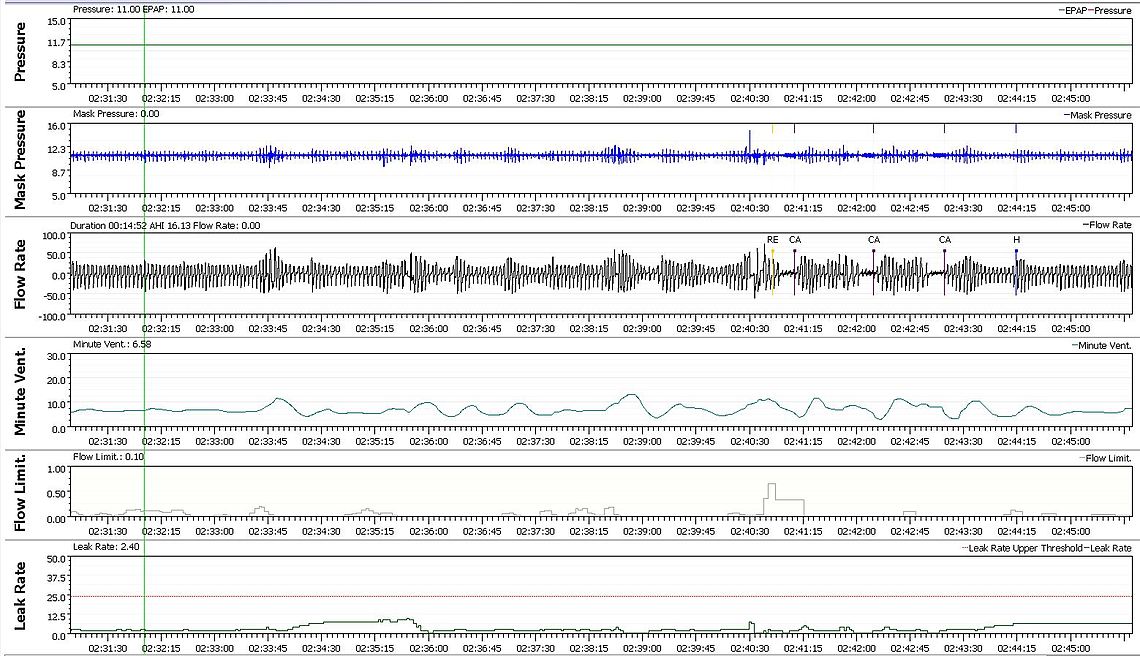My first thought is that this is not a OSCAR or SleepyHead issue. All the software does is display the data that the CPAP/BiPAP machine has captured. It is the machine that determines the types of events. Yes, the machine can make mistakes, and the event classifications should not be considered as absolutely correct. However, they are a good indication of what is going on. If you want to zoom in on events to expand the scale and look at them in detail you can form your own opinion as to how accurate the classification is. I suffer from CA events, and then hypopnea events next. OA events are almost always low. Hypopnea is generally assumed to be a flow reduction due to restriction of air flow, or obstructive in nature. However, they can actually be due to reduced effort to breathe which is a central effect. My suspicion is that most of my hypopnea events are central in nature rather than obstructive. Here is an example from last night to look at zoomed in. You will see there is a series of events; RE, CA, CA, CA, H. If you look at the minute ventilation you can see that the flow was cycling prior to these events, and really started about 2:33.45. Something disturbed flow. Perhaps the mask moved or something. This was really the starting point of the event series and it is due to my issues with breathing control that cause central apnea. For whatever reason my breathing control system is not stable. If something upsets it, it starts to cycle as can be seen most easily with the minute ventilation. At the RE I may have even woken up. But you can see the cycle continues. The final event is classed as a hypopnea, but I would say almost for certain it is just a CA event that did not go to full loss of air flow. This is an example of why I more or less lump in my hypopnea events with the CA events as part of the same problem. Where the rubber hits the road is when you are trying to decide what to do about it. If the hypopnea events are obstructive in nature one would benefit from more pressure. If they are central, then more pressure may make it worse. For this night my total AHI was 3.31, with 1.66 CA, 0.25 OA, and 1.40 H. My conclusion is that if anything the pressure may be too high, not too low. This is an example of how I use SleepyHead.

If you are wondering about whether an event is a CA or OA, you can second guess that too by looking at it up close. The ResMed tries to cycle flow to see what it does to pressure. If the airway is closed the pressure will fluctuate with a higher amplitude. If the airway is open the pressure fluctuation is lower. Here is an example of two events side by side. Here is an example of the two events side by side. Notice how the mask pressure fluctuates up and down and paints a band of pressure fluctuation in response to the machine testing for obstruction. In the OA event the band or pressure fluctuation is wider than for the event that gets classed as a CA. The difference is not huge, but it is there. Does the machine sometimes make a mistake in classification? Probably at times. By my eye the machine it right in this example. And again like the previous example that H that follows the CA event is probably central in nature.

Is this potential minor inaccuracy a reason not to use OSCAR? I would think absolutely not. The alternative is to fly absolutely blind. One does have to look at the results with some thought and purpose though. And remember the data comes from the machine not from the display software. If you go to a sleep specialist and do not take your SD card with you so they can look at it, they will see almost nothing for data. If you take your card, they will see the same as what OSCAR shows you.
Hope that helps some,